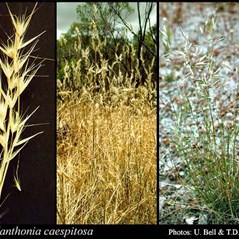Austrodanthonia caespitosa
Common Wallaby-grass
Notes
Uses: A tussock grass for native landscapes, parks and reserves. For rockeries, borders, fill-ins or planted en-mass as drifts in verges, median strips and roundabouts. Thrives in poor soils and areas of neglect.
Seed source for native birds. Caterpillar food plant for native butterfly species.
This plant is indigenous to the following botanical regions of South Australia.
:NW: North Western
:NU: Nullarbor
:FR: Flinders Rangers
:EA: Eastern
:EP: Eyre Peninsula
:NL: Northern Lofty
:MU: Murray
:YP: Yorke Peninsula
:SL: Southern Lofty
:KI: Kangaroo Island
:SE: South Eastern
For detail on these regions refer to the user guide.
- Height 0.2-0.8m
- Spread 0.2-0.2m
- Position
- Full Sun
- Family Gramineae
- Botanical Name Austrodanthonia caespitosa
- Common Name Common Wallaby-grass
- Origin SA, Vic, NSW, WA, Tas
- Habit Dense, Clumping
- Landscape 2nd line coast, Coastal cliffs, Coastal footslopes, Plains, Footslopes, Hills
- Soil Texture Clay, Loam, Sand
- pH Acidic, Alkaline, Neutral
- Tolerates Drought, Lime, Moderate frost
- Supplementary Watering Minimal
- Flower Colour Green
- Flowering Time Spring, Summer
- Flower Type Spikes
- Purpose Ornamental, Habitat
- Evergreen/Deciduous Evergreen
- Form Grass Sedge or Flax
- Indigenous to the Adelaide Region







